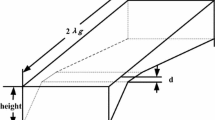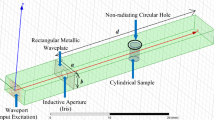Abstract
In this letter, a microwave cavity for investigating the effect of external microwave fields on the dielectric behavior of semiconductor material is proposed. We use a dual-mode rectangular cavity where the stimulus and test signals are supplied by two different swept frequency microwave sources. By adjusting the power level of the stimulus signal, the intensity of microwave field in the cavity is changed. Two band-stop filters are introduced to isolate the signals coming from the stimulus signal. Measurement results show that the dielectric properties of indium phosphate manifest nonlinear behavior under the electronic field intensity of \(10^{5}\)V/m. From the experimental result and theoretical analysis, we conclude that the nonlinear behavior is caused by the material’s inherent characteristics.
Similar content being viewed by others
Avoid common mistakes on your manuscript.
1 Introduction
Research on the measurement of dielectric property of materials is important because those properties are needed before the materials can be used. The cavity perturbation technique is the most common resonator-based approach for measurements of low loss materials [3, 4].
Due to the increasing miniaturization of microwave integrated circuits and the rapid development of high power microwave technology, the properties of the materials as affected by the external microwave field have attracted the attention of researchers. It is found that the dielectric property of polar liquids and primary alcohol mixtures changes under microwave field [5, 7]. Lots of research has been reported about ionizing radiation effects on electrical properties of dielectric materials [1, 2, 6]. An increase in the conductivity of pentacene, a kind of organic semiconducting material, is found when exposed to ionizing radiation. This is a controlled method of doping organic semiconducting materials [6]. However, the investigation of materials’ dielectric property under strong microwave field is still very relevant.
In this letter, we have developed a dual-mode rectangular cavity to investigate the influence of external microwave field on the dielectric property of semiconductor material. One mode is used to create a strong electrical field, while the other mode is for measuring. In order to prevent the stimulating signal from affecting the testing signal, two band-stop filters, whose center frequencies are the same as that of the stimulating signal, are introduced. Upon measurement, the dielectric property of indium phosphate (InP) is found to slightly change under the strong electromagnetic environment, which shows that it is an inherent characteristic of the material itself than microwave heating causing the nonlinear phenomenon.
2 Design of the Dual-Mode Rectangular Cavity
A rectangular cavity was designed to have two modes, \(TE_{102}\) and \(TE_{103}\). The former mode is used to produce a strong microwave field and the latter mode measures the dielectric property with a low power signal. The structure schematic of the rectangular cavity is given in Fig. 1. By adjusting the size of the cavity, the \(TE_{102}\) and \(TE_{103}\) modes work at the frequencies around 2.45GHz and 3.13GHz respectively. The cavity parameters are as follows: width = 83.36mm, height = 43.18mm, L = 172mm.
Figure 2 shows the model of the cavity and the electric field distributions of both resonant modes in the cavity by High Frequency Simulator Structure. The electric field distributions of both resonant modes in the cavity are shown in Fig. 2. The strongest electric field of the \(TE_{102}\) mode lies at L/4 and 3*L/4 in the cavity. The strongest electric field of the TE103 mode lies at L/6, 3*L/6 and 5*L/6 in the cavity.
From Fig. 2, it is easy to see that if the stimulating signal is injected through a probe at L/4 of the cavity, \(TE_{102}\) will be activated. The sample under test is put at the 3*L/4 in the cavity, which is the strongest electric field location for the \(TE_{102}\) mode. If the power level of stimulating signal changes, the electric field strength around the sample will be changed too. Finally, the dual-mode rectangular cavity is fabricated and coated with silver. By adjusting the probe, a good match is achieved at the stimulating port, which ensures high power signal being injected into the cavity.
3 Experimental Setup
Using the dual-mode rectangular cavity, a test system setup is shown in Fig. 3.
The stimulating signal can be amplified by an amplifier, whose frequency is the same as that of the \(TE_{102}\) mode, and the maximum output of the amplifier is about 53dBm. The reflection between the source and the power amplifier is reduced by isolators. The testing signal is provided by the vector network analyzer (VNA), whose frequency is around the working frequency of the \(TE_{103}\). Through a coupling loop and a probe, the testing signal is injected into and coupled out of the cavity for measuring the dielectric property. In addition, the two band-stop filters with a more than 30dB attenuation in the stop band, are introduced to isolate the signals coming from the stimulating source. The center frequency of the two band-stop filters is around the frequency of the stimulating signal. The experimental setup is shown in Fig. 4.
4 Experiment and Discussion
An InP sample is placed at 3*L/4 of the cavity and the source is switched-off initially. The transmission curve of the testing signals is obtained by the VNA, shown as the black curve in Fig. 5. Then the output of the source is adjusted to 0dBm and the red transmission curve is obtained as shown in Fig. 5. Mark the red curve and hold the output of the source at 0dBm for 10s. After that, the output of the source is shut down, and the red transmission curve changes to the blue curve shown in Fig. 5.
According to the cavity perturbation method, as expressed by equations (1) and (2), the real part of the dielectric constant is determined from the shift of the resonant frequency, while the imaginary part causes the variation in the Q of the cavity [4]. Therefore, it can be easily deduced that the dielectric constant of the InP has changed at different microwave field intensities.
where \(\omega \) and \(\omega _{0}\) are the angular resonant frequencies before and after the perturbation, respectively. \(Q\) and \(Q_{0}\) are the quality factors before and after the perturbation. \(\vec {E}\) and \(\vec {E_{0}}\) are the electric field strengths before and after the perturbation in the cavity. W is the total store energy in the cavity. And ε′ and \(\varepsilon ^{\prime \prime }\) are the real and imaginary parts of the dielectric constant, respectively.
In the experiment, the output of the source remains at 0dBm for 10s. Suppose the sample has been heated and the nonlinearity is caused by the heating. The thermal conductivity of InP is only \(0.7 W\cdot \)cm− 1 K− 1, which means that the heat dissipation of the InP sample is not very good. That is to say, after we shut down the output of the source, the red curve will not change to the blue one immediately. However, in the experiment, the red curve changes to the blue one immediately when we shut down the source.
To further examine the conclusion that the nonlinear behavior of the dielectric property of InP is largely caused by the material itself than by heating, an additional experiment is conducted. In the experiment, the output of the source remains at 0dBm for 1min and then the source is shut down. The results are shown in Fig. 6.
In Fig. 6, we can see that the blue curve is no longer coincides with the black one as the holding time is increased from 10s to 1min. The frequency shift starts to change with the hold time increasing. The reason is that after a longer time under microwave heating, the sample was heated a little bit, and its dielectric property changed a little bit. However, the frequency difference between the blue curve and the black curve is far less than the difference between the red curve and the black curve. Thus, we think that it is the non-thermal effect that influences the dielectric property of InP in the microwave range.
5 Conclusion
In this contribution, a new experimental method and apparatus are introduced for investigating the dielectric property of microwave semiconductor materials under microwave field through a dual model rectangular cavity. The stimulation signal and the test signal are supplied by two different frequency microwave sources. By changing the power level of the signal, the local electric field around the sample can be changed. Two band-stop filters isolate the two signals. In the experiment, more than 50W of power is injected into the cavity when the source output is 0dBm, and the electric field strength around the sample is nearly \(10^{5}\)V/m. Under the strong microwave field, the nonlinear characteristic of InP is evaluated in the microwave range. Through the experimental observation, we deduced that it is a kind of non-thermal effect that causes the interaction between the external microwave field and the material.
References
Garca H, Dueãas S, Gastán H, Gómez A, Bailón BR, Kuli K, Ritala M , Leskelaä M (2009) Irradiation effect on dielectric properties of hafnium and gadolinium oxide gate dielectrics. J Vac Sci Technol B 27(1):416–420
Hoffman EN, Skidmore TE (2009) Radiation effects on expoxy/carbon-fiber composite. J Nucl Mater 392(2):371–378
Jha AK, Akhtar MJ (2015) An improved rectangular cavity approach for measurement of complex permeability of materials. IEEE Trans Instrum Meas 64(4):995–1003
Kik A (2016) Complex permittivity measurement using a ridged waveguide cavity and the perturbation method. IEEE Trans Microw Theory Tech 64(11):3878–3886
Matyushov DV (2015) Nonlinear dielectric response of polar liquids. J Chem Phys 142(24):244502
Raval HN, Sutar DS, Nair PR, Ramgopal Rao V (2013) Investigation of effects of ionizing radiation exposure on material properties of organic semiconducting oligomer-Pentacene. Organic Elecron 14(6):1467–1476
Sun H (2015) Experimental study of dielectric property changes in DMSO-primary alcohol mixtures under lowintensity microwaves. Rcs Adv 5(75):61031–61034
Acknowledgments
The authors acknowledge the support from the National Natural Science Foundation of China (Grant Nos. 61671123 and 61001027) and the Open Foundation of National Engineering Research Center of Electromagnetic Radiation Control Materials (ZYGX2016K003-7).
Author information
Authors and Affiliations
Corresponding author
Additional information
Responsible Editor: T. Xia
Rights and permissions
About this article
Cite this article
Gao, Y., Li, E. & Guo, G. Measurement of Nonlinear Dielectric Behaviour of Semiconductor Material Under Microwave Field in Dual-Mode Rectangular Cavity. J Electron Test 34, 203–207 (2018). https://doi.org/10.1007/s10836-018-5718-9
Received:
Accepted:
Published:
Issue Date:
DOI: https://doi.org/10.1007/s10836-018-5718-9










